射频加热技术在粮食储藏与加工中应用研究进展
2021-03-29李洪岳李青鸾郑建军令博王绍金
李洪岳 李青鸾 郑建军 令博 王绍金
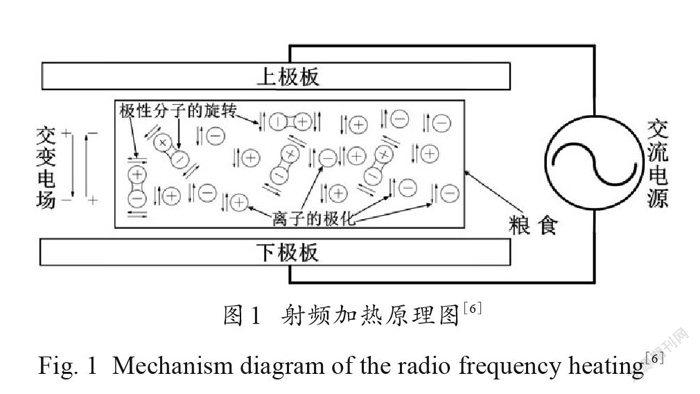

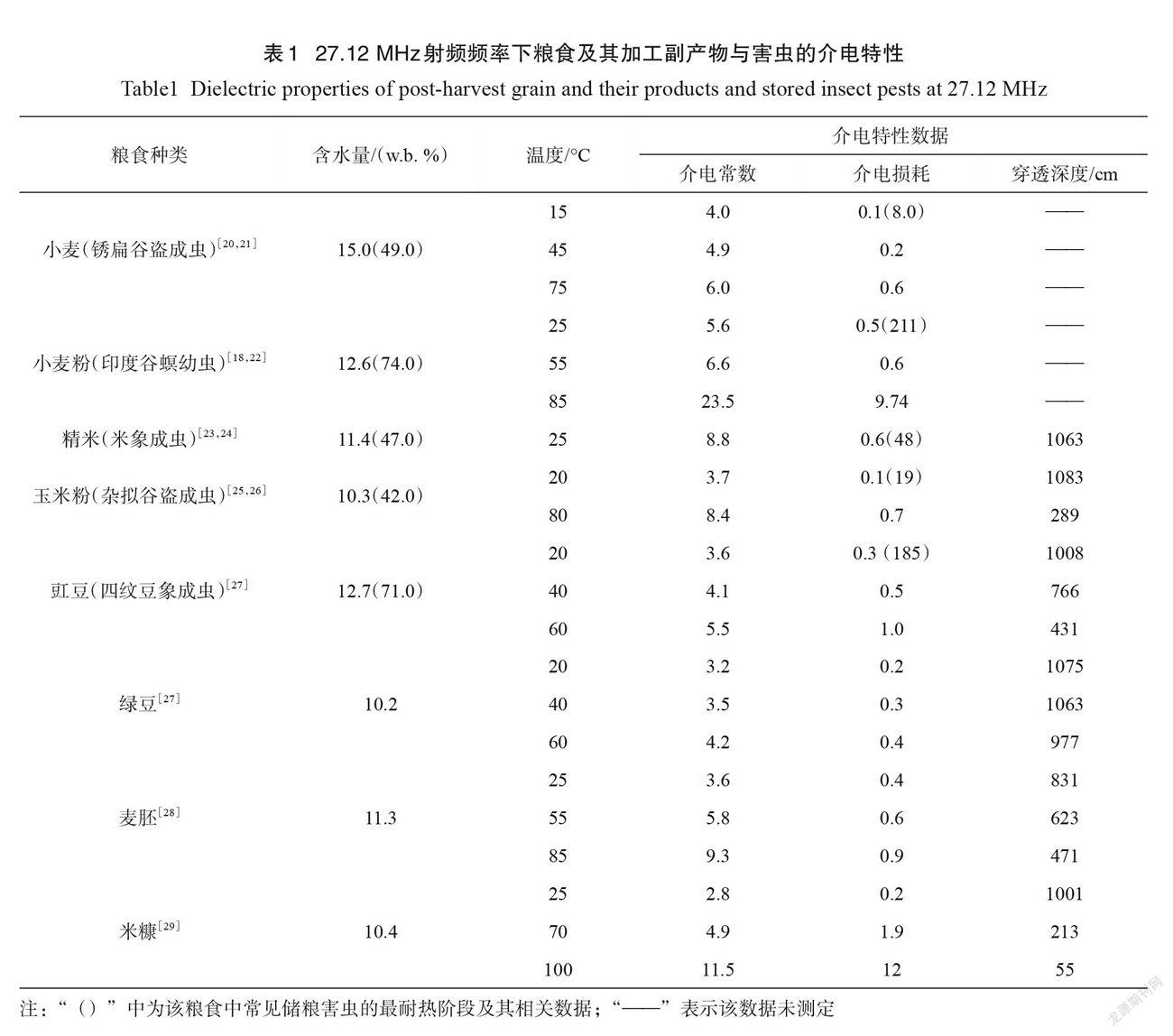
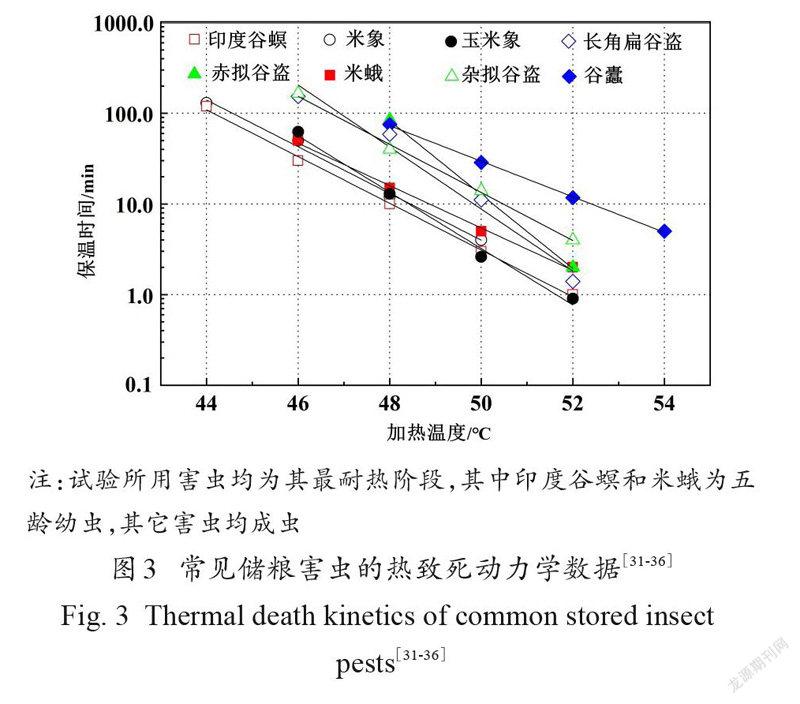

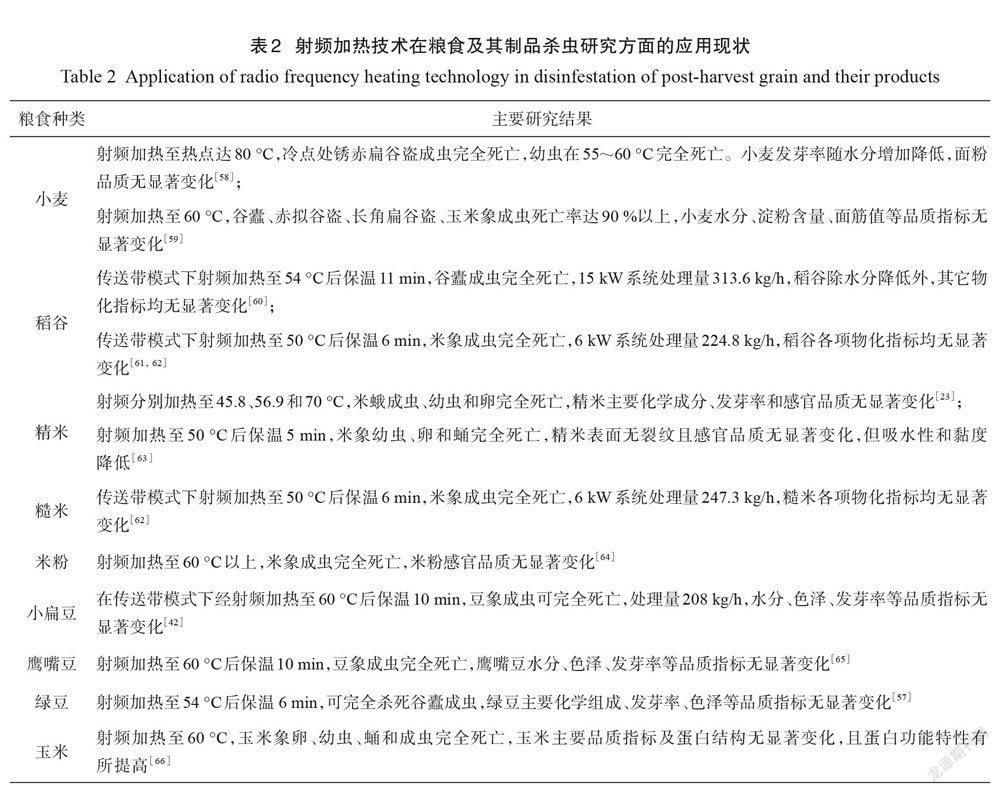
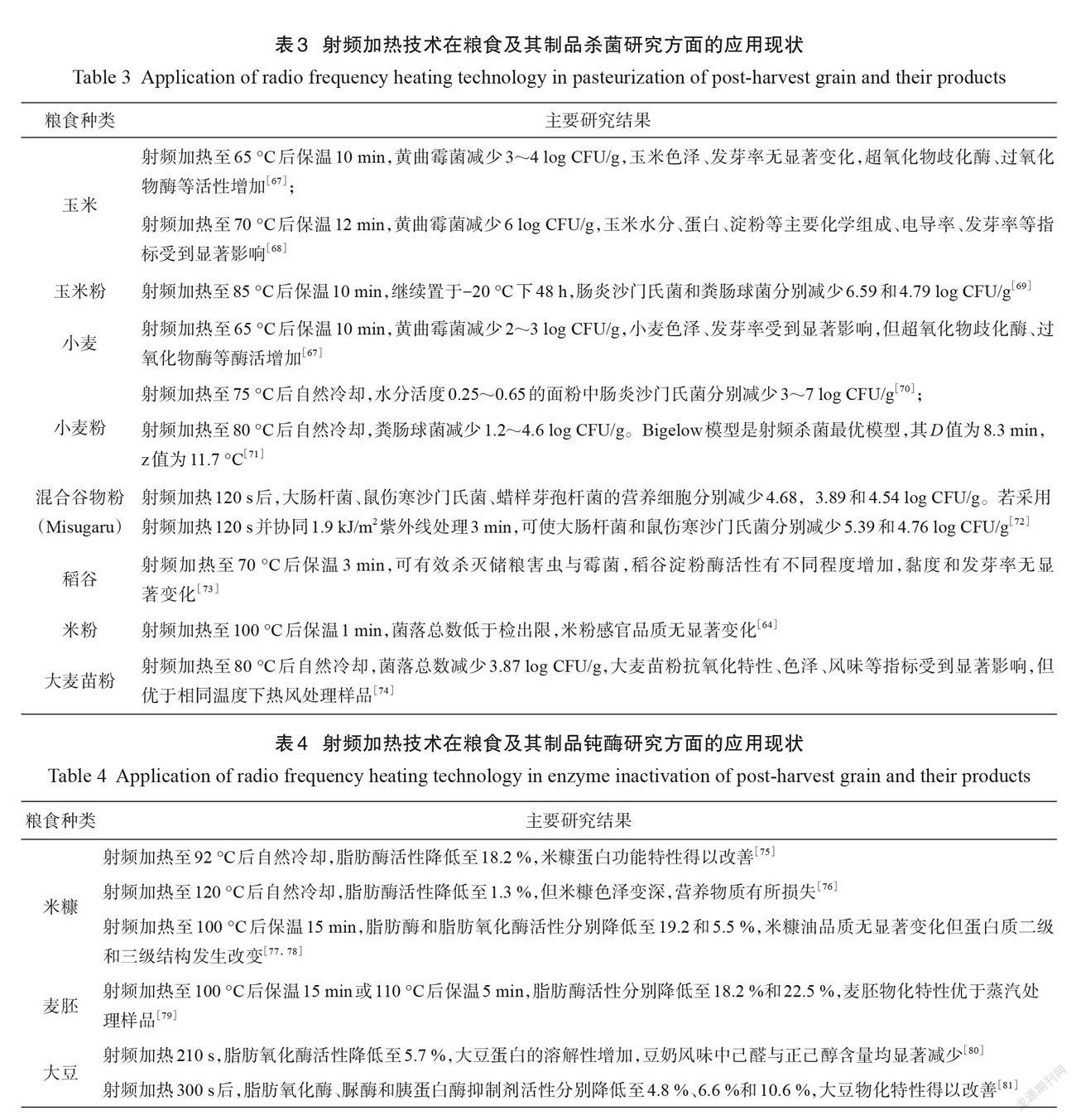
摘要:粮食的储藏与加工是保障国家粮食安全的重要环节。射频技术凭借具有穿透深度大、加热迅速、整体加热、无化学残留等特点,已广泛应用于粮食产后研究,并在部分领域工业化应用前景广阔。为深入了解射频加热技术在粮食储藏与加工中应用研究进展,本文首先对射频技术展开概述,阐述了射频加热的基本原理,并对目前商业化应用的射频加热系统的类型与特点进行介绍;从粮食与储粮害虫的介电特性、储粮害虫的耐热性和粮食的加热均匀性改善三个方面概述了目前射频在粮食储藏与加工中的基础研究;在此基础上,结合生产中面临的实际问题对该技术在粮食产后杀虫、灭菌、钝酶和干燥等方面的应用进行了总结;最后,就该技术应用于粮食储藏与加工尚存的问题与未来研究方向提出了建议。本文可为射频技术在粮食储藏与加工中的应用研究提供指導作用。
关键词:射频加热;产后粮食;杀虫;灭菌;钝酶;干燥
中图分类号: TS255.36;S37文献标志码: A文章编号:202106-SA001
引用格式:李洪岳,李青鸾, 郑建军, 令博, 王绍金. 射频加热技术在粮食储藏与加工中应用研究进展[J].智慧农业(中英文), 2021, 3(4):1-13.
LI Hongyue, LI Qingluan, ZHENG Jianjun, LING Bo, WANG Shaojin. Recent advances on application of radio frequency heating in the research of post-harvest grain storage and processing[J]. Smart Agriculture, 2021, 3(4):1-13.(in Chinese with English abstract)
1 引言
“仓廪实、天下安”,粮食的储藏与加工是经济社会稳定和发展的基础。据统计,中国每年在储藏、运输和加工环节造成的粮食损失高达3500万吨[1],造成产后损失的主要因素是储粮害虫侵染、微生物污染、品质相关酶降解等。针对上述有害因素,人们通常采用化学处理,如熏蒸处理、杀菌剂处理等,但大部分化学试剂在使用过程中会造成环境污染和残留,且不合理使用还会导致害虫或微生物抗药性增强。随着人们食品安全与环保意识的增强,基于化学法的传统杀虫灭菌处理将面临限用或禁用[2]。因此,探索绿色、高效、安全的物理方法减少粮食产后损失具有重要的现实意义。
射频(Radio Frequency)是指10~300 MHz的电磁波,为避免干扰通信,美国联邦通信委员会规定仅13.56、27.12和 40.68 MHz 三个射频频率可用于工业、科学和医学领域[3]。有别于依靠内部传导,表面对流和辐射的传统加热(如热风/水和蒸汽),射频能量可穿透至物料内部,产生整体加热效应,使物料内外同步受热。此外,有别于欧姆加热,射频属于非接触式加热,可穿透纸或塑料等常规食品包装材料,避免包装时产生二次污染。而与微波或红外加热相比,射频波显著较长,穿透深度更大,针对大尺寸物料加热更为均匀[4]。
目前,射频技术已广泛应用于产后粮食及其制品的储藏与加工研究,如杀虫、灭菌、钝酶、干燥和烘培等多个领域,并表现出潜在工业化应用优势。然而,针对该技术在粮食及其制品储藏与加工中的研究目前尚未出现全面的综述报道。因此,本文将通过介绍射频加热技术的基本原理与常见操作系统,结合基于射频加热的粮食储藏与加工基础研究现状,阐述射频技术在粮食储藏与加工中的应用研究现状,最后提出射频加热技术在该领域的发展建议,为射频技术在该领域的工业化应用提供指导。
2 射频加热技术概述
2.1 射频加热原理
射频加热系统的基本原理可简化为上下两极板所构成的平行板式电容器(图1)。当粮食处于电极之间时将产生两种现象:一种是空间电荷极化,即粮食中的带电离子在外电场作用下的迁移过程;另一种是极性分子旋转,即粮食中的水分子不断旋转以使自身与不断变化的电场极性一致。在两者共同作用下,离子和极性分子摩擦产生热能,从而引起粮食表面与内部温度升高。虽然离子极化与极性分子旋转并存,但通常认为离子极化是引起射频加热的主要因素[5]。
2.2 粮食储藏加工研究中常见的射频加热系统
基于射频加热的粮食储藏与加工研究,目前主要采用自由振荡式和50Ω 式两类射频加热系统。图2为四种常见的射频加热系统。其中自由振荡式系统应用最为广泛,它利用三极管形成的标准振荡电路产生射频能量,使极板与物料形成调谐电路,再与输出电路发生电感耦合产生热量,具有结构简单,制造成本低、加热效率高等优点,但该系统中电容会随极板间距及物料介电特性变化而改变,从而导致系统频率改变[7]。如英国Strayfield公司 SO6B型自由振荡式射频加热系统,通过调节极板间距(9~19 cm)可改变射频能量输出功率,达到不同的加热速率。该系统还配有传送带,可实现对物料的连续化处理。近年来,国产射频加热系统的制造水平也有了迅速发展,如河北华氏纪元电器已开发并生产出基于自由振荡式电路的不同频率、功率、单批次或中试规模的多种射频加热系统,并被国内多家科研单位使用[8]。50Ω射频加热系统的主要结构与自由振荡式系统相似,但该系统具有自动协调装置,可自动调节使工作电路总阻抗保持在50Ω,因而在加热过程中,具有更加稳定的耦合功率,并能提供固定频率,精确控制功率和反馈。但由于其制造成本较高,并未得到广泛使用[9, 10]。
3 射频加热技术在粮食储藏与加工中的基础研究
射频技术在粮食的储藏与加工领域具有极大潜力,而目前针对射频加热技术的基础研究主要包括粮食与储粮害虫介电特性、储粮害虫的耐热性研究和粮食的射频加热均匀与改善等。
3.1 粮食与储粮害虫介电特性
介电特性(Dielectric Properties)描述了电磁场中物料与电磁波的相互作用。它不仅决定了物料对电磁能的吸收和转化,还间接影响物料的加热速率和均匀性。介电特性包括介电常数(ε')和损耗因子(ε")两个参数,前者表示物料对电磁能的储存能力,后者反映物料对电磁能的吸收或将电磁能转换为热量的能力[15]。
介电特性受许多因素影响。对于粮食等低含水量物料,水分通常是主要因素,一般来说,随着含水量增加,介电特性数值逐渐升高[16]。由于害虫含水率较高,介电损耗远大于粮食,故在相同时间内,害虫将吸收更多能量,致使其升温速率大于粮食,这种现象被称为射频选择性加热,因此开展粮食与储粮害虫介电特性的定量分析对射频杀虫具有重要意义[17]。表1 列出了27.12 MHz下常见粮食及其制品与储粮害虫的介电特性。
研究介电特性一方面可预测射频加热过程中粮食及其制品的加热特性(如加热速率、均匀性等)。为了探究介电特性对射频加热速率及加热均匀性的影响,Lin 和 Wang[18]利用阻抗分析仪测定了掺有麸皮的小麦粉介电特性随频率、水分含量、麸皮含量和温度的变化规律,并采用27.12 MHz 、6 kW 的射频加热系统在10 cm 的极板间距下评估小麦粉的加热速率和温度分布。结果表明,水分、麸皮含量和温度对小麦粉的介电特性有显著影响,小麦粉的介电特性随温度和水分的升高而升高,随麸皮含量升高而降低。由于介电常数与损耗因子之差增大,小麦粉加热速率随水分的增大先减小后增大,随麸皮含量的减少而减小。降低水分和麸皮含量可改善射频加热均匀性。另一方面,介电特性可为计算机模拟射频加热过程提供基础数据,以便进一步优化射频系统和改善加热均匀性。Shrestha和Baik[19]为研究射频的选择性加热特性,基于小麦和锈扁谷盗的介电特性数据,采用 COMSOL 软件模拟与实验结合的方式研究了不同含水量(12%、15%和18%)下,小麦与其所含锈扁谷盗在射频加热下的温度变化过程,结果显示实验与模拟的温度偏差分别不超过13.3%、10.2%和18.1%。
3.2 储粮害虫的耐热性研究
储粮害虫的耐热数据对射频杀虫工艺的建立与优化具有重要指导意义。美国华盛顿州立大学开发了一种加热装置Heating block system ,可获得理想的加热均匀性,并在0.1~20°C/min加热速率下研究害虫的热致死参数,有效指导基于热处理的害虫杀灭研究[30]。利用该系统获得的储粮害虫热致死数据如图3所示。由图3可知,谷蠹最耐热,100%致死时需54°C 保持5 min 或50°C 保持29 min;而印度谷螟、赤拟谷盗和杂拟谷盗等在50°C 下,仅需3 min 即可100%死亡,耐热性较低。此外,由于射频加热速度显著高于传统加热,为探究射频快速加热在粮食杀虫方面的优势,Yan等[31]利用Heating block system研究发现6~8°C/min 的快速加热条件下,米象成虫死亡率显著高于0.1 或0.5°C/min 的慢速加热,并指出原因与害虫长时间暴露于非致死温度下形成了热适应有关,证明了射频等快速加热技术更有利于储粮害虫的杀灭。由图3整体来看,在保证理想的加热均匀性时,粮食经射频快速加热至55°C保温5 min或直接加热至更高温度(如60~65°C)不经保温处理,可实现对储粮害虫的有效杀灭。
3.3 粮食的射频加热均匀性与改善
3.3.1 射频加热不均匀现象产生的原因与传统及微波加热相比,射频加热虽然穿透深度更大,但加热不均匀(尤其是边角效应)仍是阻碍其工业化应用的主要问题。引起射频加热不均匀性的原因主要包括以下三个方面:
(1)电磁场分布不均匀。由于粮食与其周围介质介电特性存在显著差异,导致电磁场分布不均,产生不均匀加热[37]。如图4 (a)空载状况下极板内部可形成垂直于极板表面的均匀交变电磁场,但在极板边缘,电磁场则呈现非均匀分布。而当物料置于下极板中心位置并在上方留有空隙时(如图4(b)),由于容器、空气和物料介电特性存在差异,因此在三者交界处电磁场分布会发生改变,使电磁场在物料顶部边缘汇集导致加热不均匀,产生边角效应。由于物料通常是置于下极板中心位置加热,因此边角效应广泛存在于射频加热生产过程中。此外,当物料置于极板间的几何中心时(如图4(c)),电磁场会发生偏转,使物料中间层电磁场强度增加,温度较高[38]。
(2)热偏移现象。物料内部含水率和介电特性的差异导致了物料内部不同区域对射频能量吸收效果不同[39]。介电损耗因子越大,则吸收的射频能量越大。由于介电损耗因子与温度呈正相关,因此在射频加热过程中,介电损耗较高的热点会吸收更多的射频能量,进而出现过度加热[37]。热偏移是导致射频加热不均匀的重要原因,也是阻碍该技术商业化应用的最大障碍,尤其是当物料的初始温度、含水率或介电特性差异较大时,该现象更为严重[4]。
(3)物料形状效应。物料的形状、大小等因素会对射频波的反射、折射、穿透和吸收等过程产生影响,进而引发加热不均匀现象。Huang 等[40]利用计算机模拟并验证了不同粒径大小和位置的黄豆在射频加热过程中的加热均匀性,结果表明颗粒直径越小的物料加热越均匀,直径为 1 cm的单个大豆内部的最大温差为3°C ,而直径为5 cm的颗粒内部最大温差为39°C 。直径为1、2 、3、4和5 cm的颗粒物料内部温度变化分别为 74% 、113% 、121% 、143%和153% 。Bedane等[41]制備了不同形状的食品模拟样品以研究不同几何形状(立方体、圆柱体和球体)和取向(垂直和水平)的温度分布。试验结果表明,样品采用垂直取向具有更好的温度分布,其中圆柱体样品的加热均匀性最好,立方体次之。最大的加热速率和能量吸收率发生在球型样品和水平取向的圆柱样品的底部截面。
3.3.2 射频加热均匀性的改善
射频加热不均匀极大影响了粮食及其制品的热处理效果。其中,局部过热往往导致物料过度加热影响产品品质,而冷点产生将导致热处理达不到预期效果(如杀虫灭菌不彻底),产生潜在的食品安全问题[42,43]。目前针对改善射频加热均匀性的研究主要从以下三方面开展。
(1)改变电磁场分布。主要包括三种方式。第一种是利用特殊的电磁波导体(Electromag‐netic Wave Conductors)增加冷點处对电磁波的吸收以提高冷点温度改善加热均匀性,即根据不同介电特性介质间的电场线弯曲理论,将电磁波导体放置在食品内部或覆盖在食品表面,以此保证电磁强度较低的区域引入更多电磁能量[19,44]。如 Ling 等[28]在麦胚样品的顶部和底部(冷点)覆盖一对矩形聚醚酰亚胺片,并通过实验证实聚醚酰亚胺片可显著提高样品冷点温度并改善加热均匀性,且使麦胚中脂肪酶失活更加均匀。
第二种是降低物料与周围介质介电特性差异,减少射频能量在物料边缘和角落的聚集,抑制热偏移和边角效应。常用方法是选取与物料介电特性相似的材料作为容器材料或包覆于物料周围,减少了物料边角处因介电特性差异而导致的电磁场聚集。如 Huang 等[45]在黄豆射频杀虫研究中发现,由于聚苯乙烯介电常数与黄豆接近且损耗因子较低,因此与聚丙烯相比,聚苯乙烯容器加热均匀性更好,同时在一定范围内增加容器拐角半径和侧壁厚度可进一步改善加热均匀性。
第三种是改变物料整体形状或体积,减少射频能量在边角区域的聚集。如Yu等[46]研究了不同大小容器中油菜籽的射频加热均匀性,结果显示,与小容器中的样品相比,中等大小样品的边角效应更加严重,但大容器中的样品(尺寸大于极板面积)并未发现这一现象,证明样品上表面积大于极板面积时边角效应不明显。
(2)改变物料在电磁场中的位置。通过改变物料在电磁场中的位置使样品中热点与冷点位置不断变化,提高加热均匀性。常见方法包括旋转、传送带输送、搅拌和螺旋式输送。如Palazoğlu和Miran[47]将装满面粉的矩形容器置于可旋转的转盘中,并利用传送带输送,将旋转和平移相结合进一步降低了矩形容器内小麦粉的温度梯度。Chen 等[48]基于 COMSOL软件建立了静态和动态条件下小麦样品的射频加热模型。模拟和实验结果均表明,传送带输送可改善小麦的射频加热均匀性。Chen等[49]用计算机模拟和实验验证的方式研究了27.12 MHz射频加热条件下搅拌混合对小麦样品温度分布的影响。结果表明,随着混合次数的增加,射频处理小麦样品的加热均匀性指数呈下降趋势。此外,螺旋输送的方式可实现在输送过程中不断对物料进行搅拌以提高加热均匀性。Zhou 和 Wang[50]采用定制的螺旋输送器分别对大豆、玉米和花生进行螺旋输送,结果表明,采用螺旋输送的方式可改善加热均匀性,降低射频加热均匀性指数。
(3)控制射频系统工作参数。射频加热时极板的电压、形状、尺寸和间距(功率输出)等因素均会影响加热均匀性[51]。通常情况下射频加热速率越快,边角效应和热偏移现象越明显,因此调节射频系统的工作参数可有效改善加热均匀性。物料射频加热时极板间距的选取是保障加热均匀性的首要因素,如 Shi等[52]通过计算机模拟与实验验证的方式研究了小麦粉在不同极板间距下的加热均匀性。结果表明,加热均匀性指数和升温速率随电极距离的增加而减少,加热速率与极板距离呈负相关。Huang 等[53]通过计算机模拟与实验验证的方法研究了上极板面积对大豆加热均匀性的影响,随着上极板面积的逐渐减小,加热均匀性指数会先减小后增大。对比初始上极板尺寸(83 cm×40 cm),使用较小的上极板尺寸(35 cm×25 cm)可获得更好的加热均匀性。除此,Wang 等[54]还指出在射频加热实际过程中,上极板边角部位的电压要高于中心区域,电压分布的不均匀也会加剧物料的加热不均匀。通过对射频上极板内部电感位置和馈电条的对称设计可提高射频加热均匀性。
除了上述三种方法外,采用两种或多种方法协同还可进一步提高射频加热均匀性。如Zheng等[55]在玉米的射频加热中通过辅以70°C热风、6.6 m/h 的传送带输送、两次混合搅拌以及热风保温等方式有效改善了射频加热均匀性。目前,协同法已广泛用于大米[56]、绿豆[57]、小麦[43]等粮食作物的采后射频杀虫研究中,该方法在未来的工业化射频热处理中具有重要实用价值。
4 射频技术在粮食储藏与加工中应用研究进展
目前射频技术在粮食储藏与加工中的应用主要包括储粮害虫和有害微生物的杀灭、品质相关酶活性的钝化、干燥处理以及其它应用。
4.1 储粮害虫的杀灭
粮食及其制品的储藏过程中,害虫不仅可直接取食造成粮食品质损失,还可促进霉菌生长并产生毒素引发食品安全问题。射频凭借其快速加热、整体加热和选择性加热等优势已被广泛用于储粮害虫的杀灭研究,并成为最具潜力工业化应用的新型杀虫技术,表2对粮食及其制品的射频杀虫研究进行了总结。
由于储藏和加工阶段的粮食及其制品含水量较低,因此在射频杀虫处理过程中具有更好的加热均匀性且通常对品质无显著性影响。随着介电特性、害虫与粮食的耐热特性等基础研究的发展,射频杀虫技术逐渐扩展到不同粮食及其制品的工业规模研究中。此外,害虫的侵染会促进微生物的繁殖,使粮食受到害虫虫卵及微生物孢子的侵害。由于射频杀虫所需强度较低,因此将其与巴氏杀菌、干燥或钝酶等目的结合并开展相关研究有利于优化商业处理工艺,降低处理成本。
4.2 有害微生物的杀灭
粮食在种植、收获和储运阶段均会受到各类微生物污染,一旦外界条件适宜,微生物就会迅速繁殖,产生潜在的食品安全问题。表3对粮食及其制品的射频杀菌研究进行了总结。
射频加热在粮食中有害微生物的杀灭中表现出巨大潜力。然而,部分微生物耐热性极强,射频灭菌仍需要较高的强度,易于对粮食中的热敏性成分产生不利的影响。因此,针对粮食作物中热敏性和功能性成分开展相关研究对保障射频灭菌下粮食及其制品的品质具有重要意义。此外,现有研究还表明射频结合热风、热水、冷冻或紫外等可获得更高的灭菌效率和更好的灭菌效果。
4.3 品质相关酶活性的抑制
粮食收获后部分酶仍具有一定活性,这些酶往往导致粮食色泽、风味、口感和营养产生不利变化。因此,对产后粮食及其制品中品质相关酶进行抑制或钝化十分必要。表4总结了粮食及其制品中酶的射频钝化研究现状。
目前射频技术在粮食及其制品钝酶方向的研究较少。现有研究中钝酶的目标主要集中在与风味产生相关的酶和与颜色变化相关的酶。与射频灭菌处理相似,酶灭活也需要较高的射频强度,这对粮食及其制品的品质保障带来了一定挑战。此外,尽管射频具有快速加热的优势,但目前针对粮食及其制品的射频钝酶研究仍为小批量的实验室规模,尚未开展射频工业规模的钝酶研究。
4.4 干燥处理
射频技术在粮食的干燥处理中也有广泛应用。如谢永康等[82]针对英国产Strayfield SO6B型射频加热系统在干燥过程中存在加热不均匀、热风效率低、无法在线称重等问题,进行了结构优化与改进。通过采用多层物料盘堆叠,结合侧向热风对流辅助干燥等方式有效解决了射频干燥中出现的热偏移和边角加热效应,提高了干燥均匀性。
4.5 其它应用
除上述应用外,近年来也有研究者利用射频加热开展了新收获稻谷的陈化研究,以改善新鲜大米烹饪后普遍存在的黏度大、口感差等问题[83]。结果显示,稻谷含水量16.3% ,射频加热45 min为最优陈化参数。与自然陈化相比,射频陈化可显著缩短陈化时间,且可较好地保持大米品质。
5 未来研究展望
尽管射频加热技术已广泛应用于粮食及其制品储藏和加工研究的多个领域,但仍然需要更多的研究以实现高效加工处理并工业化应用。基于目前的研究现状,未来还需在以下几个方面开展深入研究。
(1)研发设计针对粮食储藏加工的专用射频加热系统。目前,已有研究所采用的射频加热系统均为通用设备(即未针对某种特定目标研发的射频加热系统)。因此,未来可考虑针对粮食这类特定物料(如低水分、颗粒状、粉状等共性特点),结合射频加热均匀性改善研究,开发针对粮食杀虫、灭菌、钝酶、干燥等处理的专用射频加热系统,以更好地满足科学研究与工业化应用需求。
(2)射频协同其它技术在粮食储藏加工研究中的应用。目前,相比传统热处理技术,尽管射频加热具有速度快、时间短、温度更均匀等优势,但粮食的低水分特性导致微生物与酶耐热性极强,射频杀菌或钝酶仍需较高强度,对品质保持带来了一定挑战。因此,未来可考虑采用其它物理或化学手段协同射频加热,进一步提高热处理效率,降低粮食品质损失。
(3)目前射频干燥过程多采用单一方法,这使得粮食在前期受热率和干燥速率较低而在后期产生加热失控和品质下降。因此,未来在粮食射频干燥过程中可将整个周期划分为多阶段,针对不同阶段采取多级干燥的方式提高加热均匀性和产品品质。
(4)射频杀虫的工业化应用。射频杀虫是该技术在粮食储藏与加工领域开展最早且研究最为深入的方向,通过多年研究已积累了丰富的基础性数据。因此,未来应主要针对工业化射频杀虫过程中粮食的加热均匀性、品质以及能耗效率等开展深入研究,早日实现其工业化应用。
参考文献:
[1]竹立家. 必须从国家战略的高度深刻认识粮食安全——对习近平总书记关于制止餐饮浪费行为重要指示精神的解读[J].理论探讨, 2020(5):5-10.
ZHU L. Deeply understand food security from the height of nationalstrategy—Interpretation of generalsecretary Xi Jinping's important instructions on stopping food waste[J]. Theoretical Investigation, 2020(5):5-10.
[2] MACANA R J, BAIK O D. Disinfestation of insectpests in stored agricultural materials using microwaveand radio frequency heating: A review[J]. Food Reviews International, 2018, 34(5):483-510.
[3] PIYASENA P, DUSSAULT C, KOUTCHMA T, et al.Radio frequency heating of foods: Principles, applications and related properties—A review[J]. Critical Reviews in Food Science and Nutrition, 2003, 43(6):587-606.
[4]劉嫣红, 杨宝玲, 毛志怀. 射频技术在农产品和食品加工中的应用 [J].农业机械学报 , 2010, 41(8):115-120.
LIU Y, YANG B, MAO Z. Radio frequency technologyand its application in agro-product and food processing[J]. Transactions of the CSAM, 2010, 41(8):115-120.
[5] JIAO Y, TANG J, WANG Y, et al. Radio-frequency applications for food processing and safety[J]. Annual Review of Food Science and Technology, 2018, 9(1):105-127.
[6] AWUAH G, RAMASWAMY H, TANG J. Radio frequency heating in food processing: Principles and applications[M]. Boca Raton, Florida: CRC Press, 2015:106-108.
[7] ZHAO Y, FLUGSTAD B, KOLBE E, et al. Using capacitive (radio frequency) dielectric heating in foodprocessing and preservation: A review[J]. Journal ofFood Process Engineering, 2000, 23(1):25-55.
[8] MAO Y, WANG P, WU Y, HOU L, et al. Effects of various radio frequencies on combined drying and disinfestation treatments for in-shell walnuts[J]. LWT-FoodScience and Technology, 2021, 144: ID 111246.
[9]周洪學. 射频系统加热性能及均匀性改善研究[D].杨凌:西北农林科技大学, 2018.
ZHOU H. Heating performance and uniformity improvement of radio frequency systems[D]. Yangling:Northwest A&F University, 2018.
[10] MOIRANGTHEM TT, MACANA R, BAIK O D.Characterization of 50-ohm radio frequency heating ofbulk canola seeds (Brassica napus. L) in a tubular applicator with parallel electrodes and post-treatmentquality[J]. Innovative Food Science & Emerging Technologies, 2020, 64: ID 102409.
[11] 令博. 开心果采后射频杀虫技术及综合利用研究[D].杨凌:西北农林科技大学, 2016.
LING B. Studies on radio frequency disinfestationtechnology and comprehensive utilizations of postharvest pistachio[D]. Yangling: Northwest A&F University, 2016.
[12] ZHOU H, GUO C, WANG S. Performance comparisonbetween the free running oscillator and 50Ω radio frequency systems[J]. Innovative Food Science & Emerging Technologies, 2017, 39:171-178.
[13] MACANA R J, MOIRANGTHEM T T, BAIK O D.50ohm RF technology based applicator design and fabrication for disinfestation of insect pests in stored grains[C]// 2018 ASABE Annual International Meeting. St. Joseph, MI, USA: ASABE, 2018.
[14] CUI M, SUN W, XIA L, et al. Effect of radio frequency heating on the mortality of Rhizoperthadominica (F.) and its impact on grain quality[J]. Journal of Stored Products Research, 2020, 89: ID 101695.
[15] ROUTRAY W, ORSAT V. Recent advances in dielectric properties—Measurements and importance[J]. Current Opinion in Food Science, 2018, 23:120-126.
[16] TIWARI G, WANG S, TANG J, et al. Analysis of radiofrequency (RF) power distribution in dry food materials[J]. Journal of Food Engineering, 2011, 104(4):548-556.
[17] KRAUS M, HOLZER F, HOYER C, et al. Chemicalfree pest control by means of dielectric heating with radio waves: Selective heating[J]. Chemical Engineering and Technology, 2018, 41(1):116-123.
[18] LIN B, WANG S. Dielectric properties, heating rate,and heating uniformity of wheat flour with added bran associated with radio frequency treatments[J]. Innovative Food Science & Emerging Technologies, 2020, 60: ID 102290.
[19] SHRESTHA B L, BAIK O D. Multi-physics computersimulation of radio frequency heating to control pest insects in stored-wheat[J]. Engineering in Agriculture, Environment and Food, 2019, 12(1):71-80.
[20] SHRESTHA B L, BAIK O D. Dielectric behaviour ofwhole-grain wheat with temperature at 27.12 MHz: A novel use of a liquid dielectric test fixture for grains[J]. International Journal of Food Property, 2015, 18(1):100-112.
[21] SHRESTHA B L, BAIK O D. Radio frequency selective heating of stored-grain insects at 27.12MHz: A feasibility study[J]. Biosystems Engineering, 2013, 114(3):195-204.
[22] WANG S, TANG J, JOHNSON J A, et al. Dielectricproperties of fruits and insect pests as related to radio frequency and microwave treatments[J]. Biosystems Engineering, 2003, 85(2):201-212.
[23] YANG C, ZHAO Y, TANG Y, et al. Radio frequencyheating as a disinfestation method against Corcyracephalonica and its effect on properties of milledrice[J]. Journal of Stored Products Research, 2018, 77:112-121.
[24] NELSON S O, BARTLEY P G, LAWRENCE K C. RFand microwave dielectric properties of stored-grain insects and their implications for potential insect control[J]. Transactions of the ASAE, 1998, 41(3):685-692.
[25] OZTURK S, KONG F B, SINGH R K, et al. Radio frequency heating of corn flour: Heating rate and uniformity[J]. Innovative Food Science & Emerging Technologies, 2017, 44:191-201.
[26] NELSON S. RF and microwave permittivities of insects and some applications[C]// URSI EMTS International Symposium on Electromagnetic Theory. Pisa, Italy: Pisa University, 2004:1224-1226.
[27] JIAO S, JOHNSON J A, TANG J, et al. Dielectricproperties of cowpea weevil, black-eyed peas andmung beans with respect to the development of radiofrequency heat treatments[J]. Biosystems Engineering,2011, 108(3):280-291.
[28] LING B, LYNG J G, WANG S. Radio-frequency treatment for stabilization of wheat germ: Dielectric properties and heating uniformity[J]. Innovative Food Science & Emerging Technologies, 2018, 48:66-74.
[29] LING B, LIU X, ZHANG L, et al. Effects of temperature, moisture, and metal salt content on dielectricproperties of rice bran associated with radio frequencyheating[J]. Scientific Reports, 2018, 8(1):4427.
[30] 嚴荣军. 储藏害虫热致死动力学与气调加热板加热均匀性研究[D].杨凌:西北农林科技大学, 2015.
YAN R. Thermal death kinetics of storage pests andheating uniformity of controlled atmosphere/heatingblock systems[D]. Yangling: Northwest A&F University, 2015.
[31] YAN R, HUANG Z, ZHU H, et al. Thermal death kinetics of adult Sitophilus oryzae and effects of heatingrate on thermotolerance[J]. Journal of Stored ProductsResearch, 2014, 59:231-236.
[32] HOU L, WU Y, WANG S. Thermal death kinetics ofCryptolestespusillus (Schonherr), Rhyzoperthadominica (Fabricius), and Triboliumconfusum (Jacquelin duVal) using a heating block system[J]. Insects, 2019, 10(5):1-13.
[33] YANG L, LI Z, MA W, et al. Thermal death kinetics offifth-instar Corcyrascephalonica (Lepidoptera: Galleriidae)[J]. Journal of Insect Science, 2015, 15: ID25843578.
[34] LI W, WANG K, CHEN L, et al. Tolerance of Sitophilus zeamais (Coleoptera: Curculionidae) to heated controlled atmosphere treatments[J]. Journal of Stored Products Research, 2015, 62:52-57.
[35] JOHNSON J A, VALERO K A, WANG S, et al. Thermal death kinetics of red flour beetle (Coleoptera: Tenebrionidae) [J]. Journal of Economic Entomology, 2004, 97(6):1868-1873.
[36] JOHNSON J A, WANG S, TANG J. Thermal death kinetics of fifth-instar Plodia interpunctella (Lepidoptera: Pyralidae)[J]. Journal of Economic Entomology, 2003, 96(2):519-524.
[37] HUANG Z, MARRA F, WANG S J. A novel strategyfor improving radio frequency heating uniformity of dry food products using computational modeling[J]. Innovative FoodScience & Emerging Technologies, 2016, 34:100-111.
[38] JIAO Y, SHI H, TANG J, et al. Improvement of radiofrequency (RF) heating uniformity on low moisture foods with Polyetherimide (PEI) blocks[J]. Food Research International, 2015, 74:106-114.
[39] 黃智. 大豆射频加热过程有限元模拟及均匀性优化研究[D].杨凌:西北农林科技大学, 2018.
HUANG Z. Finite element simulation and uniformity optimization for radio frequency heating process of soybeans[D]. Yangling: Northwest A&F University,2018.
[40] HUANG Z, DATTAA, WANG S J. Modeling radio frequency heating of granular foods: Individual particle vs. effective property approach[J]. Journal of Food Engineering, 2018, 234:24-40.
[41] BEDANE T F, ERDOGDU F, LYNG J G, et al. Effectsof geometry and orientation of food products on heating uniformity during radio frequency heating[J]. Food and Bioproducts Processing, 2021, 125:149-160.
[42] JIAO S, JOHNSON J A, TANG J, et al. Industrialscale radio frequency treatments for insect control in lentils[J]. Journal of Stored Products Research, 2012, 48:143-148.
[43] 陈龙. 运动与搅拌对小麦射频加热均匀性影响研究[D].杨凌:西北农林科技大学, 2016.
CHEN L. Effects of conveyor movement and mixing on radio frequency (RF) heating uniformity in wheat[D]. Yangling: Northwest A&F University, 2016.
[44] ZHU H, LI D, LI S, et al. A novel method to improveheating uniformity in mid-high moisture potato starch with radio frequency assisted treatment[J]. Journal of Food Engineering, 2017, 206:23-36
[45] HUANG Z, ZHANG B, MARRA F, et al. Computational modelling of the impact of polystyrene containers on radio frequency heating uniformity improvement for dried soybeans[J]. Innovative Food Science &Emerging Technologies, 2016, 33:365-380.
[46] YU D, SHRESTHA B L, BAIK O D. Temperature distribution in a packed-bed of canola seeds with variousmoisture contents and bulk volumes during radio frequency (RF) heating[J]. Biosystems Engineering,2016, 148:55-67.
[47] PALAZOĞLU T K, MIRAN W. Experimental investigation of the combined translational and rotationalmovement on an inclined conveyor on radio frequencyheating uniformity[J]. Innovative Food Science &Emerging Technologies, 2018, 47:16-23.
[48] CHEN L, HUANG Z, WANG K, et al. Simulation andvalidation of radio frequency heating with conveyormovement[J]. Journal of Electromagnetic Waves andApplications, 2016, 30(4):473-491.
[49] CHEN L, WANG K, LI W, et al. A strategy to simulateradio frequency heating under mixing conditions[J].Computers and Electronics in Agriculture, 2015, 118(C):100-110.
[50] ZHOU H, WANG S. Developing a screw conveyor inradio frequency systems to improve heating uniformityin granular products[J]. International Journal of Agricultural and Biological Engineering, 2019, 12(3):174-179.
[51] HOU L X, JOHNSON J A, WANG S J. Radio frequency heating for postharvest control of pests in agricultural products: A review[J]. Postharvest Biology and Technology, 2016, 113:106-118.
[52] SHI H, SUN Z, YAN Z, et al. Influence of electrodedistance on heating behaviourassociated to radio frequency processing of low moisture foods[J]. Acta Alimentaria, 2017, 46(4):517-526.
[53] HUANG Z, ZHU H, YAN R, et al. Simulation and prediction of radio frequency heating in dry soybeans[J].Biosystems Engineering, 2015, 129:34-47.
[54] WANG S, LUECHAPATTANAPORN K, TANG J. Experimental methods for evaluating heating uniformityin radio frequency systems[J]. Biosystems Engineering, 2008, 100(1):58-65.
[55] ZHENG A J, ZHANG B, ZHOU L Y, et al. Applicationof radio frequency pasteurization to corn (Zea maysL.): Heating uniformity improvement and quality stability evaluation[J]. Journal of Stored Products Research, 2016, 68:63-72.
[56] ZHOU L, LING B, ZHENG A, et al. Developing radiofrequency technology for postharvest insect control inmilled rice[J]. Journal of Stored Products Research,2015, 62:22-31.
[57] SONG X, MA B, KOU X, et al. Developing radio frequency heating treatments to control insects in mungbeans[J]. Journal of Stored Products Research, 2020, 88: ID 101651.
[58] SHRESTHA B L, YU D, BAIK O D. Elimination ofcruptolestesferrungineus S. in wheat by radio frequency dielectric heating at different moisture contents[J]. Progress in Electromagnetics Research, 2013, 139:517-538.
[59] 孫为伟, 曹阳, 刘璐, 等. 射频加热防治5种储粮害虫的初步研究[J].中国粮油学报, 2019, 34(5):95-100. SUN W, CAO Y, LIU L, et al. Preliminary study on radio frequency control of 5 kinds of stored grain pests[J]. Journal of the Chinese Cereals and Oils Association, 2019, 34(5):95-100.
[60] HOU L, LIU Q, WANG S. Efficiency of industrial-scaleradio frequency treatments to control Rhyzoperthadominica (Fabricius) in rough, brown, and milled rice[J]. Biosystems Engineering, 2019, 186:246-258.
[61] ZHOU L, WANG S. Verification of radio frequencyheating uniformity and Sitophilus oryzae control in rough, brown, and milled rice[J]. Journal of Stored Products Research, 2016, 65:40-47.
[62] ZHOU L, WANG S. Industrial-scale radio frequencytreatments to control Sitophilus oryzae in rough, brown, and milled rice[J]. Journal of Stored Products Research, 2016, 68:9-18.
[63] JIAO S, SUN W, YANG T, et al. Investigation of thefeasibility of radio frequency energy for controlling insects in milled rice[J]. Food and Bioprocess Technology, 2017, 10(4):781-788.
[64] LI Y, CHEN S, YAO M. Effects of radio frequencyheating on disinfestation and pasteurization of rice flour[J]. Taiwanese Journal of Agricultural Chemistry and Food Science, 2015, 53(4):125-134.
[65] WANG S, TIWARI G, JIAO S, et al. Developing postharvest disinfestation treatments for legumes using radio frequency energy[J]. Biosystems Engineering, 2010, 105(3):341-349.
[66] HASSAN A, HOERSTEN DVON, AHMED I. Effectof radio frequency heat treatment on protein profile and functional properties of maize grain[J]. Food Chemistry, 2019, 271:142-147.
[67] JIAO S, ZHONG Y, DENG Y. Hot air-assisted radiofrequency heating effects on wheat and corn seeds: Quality change and fungi inhibition[J]. Journal of Stored Products Research, 2016, 69:265-271.
[68] ZHENG A, ZHANG L, WANG S. Verification of radiofrequency pasteurization treatment for controlling Aspergillus parasiticus on corn grains[J]. International Journal of Food Microbiology, 2017, 249:27-34.
[69] OZTURK S, LIU S, XU J, et al. Inactivation of Salmonella Enteritidis and Enterococcus faecium NRRL B2354 in corn flour by radio frequency heating with subsequent freezing[J]. LWT-Food Science and Technology, 2019, 111:782-789.
[70] VILLA-ROJAS R, ZHU M J, MARKS B, et al. Radiofrequency inactivation of Salmonella Enteritidis PT 30and Enterococcus faecium in wheat flour at differentwater activities[J]. Biosystems Engineering, 2017, 156:7-16.
[71] XU J, YANG R, JIN Y, et al. Modeling the temperature-dependent microbial reduction of Enterococcusfaecium NRRL B-2354 in radio-frequency pasteurizedwheat flour[J]. Food Control, 2020, 107: ID 106778.
[72] JEONG K O, KIM S S, PARK S H, et al. Inactivationof Escherichia coli, Salmonella enterica serovar Typhimurium, and Bacillus cereus in roasted grain powder by radio frequency heating[J]. Journal of AppliedMicrobiology, 2020, 129(5):1227-1237.
[73] 伍瀟洁, 万云雷, 韩红霞, 等. 射频处理对稻谷贮藏品质的影响[J].食品科技, 2016, 41(6):187-190.
WU X, WANG Y, HAN H, et al. Effect of radio frequency on paddy storage quality[J]. Food Science andTechnology, 2016, 41(6):187-190.
[74] CAO X, ZHANG M, CHITRAKAR B, et al. Radiofrequency heating for powder ; pasteurization of barleygrass: Antioxidant substances, sensory quality, microbial load and energy consumption[J]. Journal of the Science of Food and Agriculture, 2019, 99(9):4460-4467.
[75] 于殿宇, 郝凯越, 程杰, 等. 射频处理提高米糠稳定性及其对品质的影响[J].食品科学, 2020, 41(20):20-26.
YU D, HAO K, CHENG J, et al. Radio frequency improves the stability and quality of rice bran[J]. FoodScience and Technology, 2020, 41(20):20-26.
[76] 史乐伟, 王珂, 邓红, 等. 射频加热灭酶处理对米糠稳定性和品质的影响[J].食品工业科技, 2014, 35(12):113-117.
SHI L, WANG K, DENG H, et al. Effect of lipase deactivation through radio frequency on therice bran's quality and stability[J]. Science and Technology of Food Industry, 2014, 35(12):113-117.
[77] LING B, LYNG J, WANG S. Effects of hot air-assistedradio frequency heating on enzyme inactivation, lipidstability and product quality of rice bran[J]. LWT-FoodScience and Technology, 2018, 91:453-459.
[78] LING B, OUYANG S, WANG S. Effect of radio frequency treatment on functional, structural and thermalbehaviors of protein isolates in rice bran[J]. FoodChemistry, 2019, 289:537-544.
[79] LING B, OUYANG S, WANG S. Radio-frequencytreatment for stabilization of wheat germ: Storage stability and physicochemical properties[J]. Innovative Food Science& Emerging Technologies, 2019, 52:158-165.
[80] JIANG Y, WANG S, HE F, et al. Inactivation of lipoxygenase in soybean by radio frequency treatment[J]. International Journal of Food Science and Technology, 2018, 53(12):2738-2747.
[81] JIANG Y M, LI L, HE F, et al. Highly effective inactivation of anti nutritional factors (lipoxygenase, urease and trypsin inhibitor) in soybean by radio frequency treatment[J]. International Journal of Food Science & Technology, 2020, 56(1):93-102.
[82] 謝永康, 林雅文, 朱广飞, 等. 基于加热均匀性的射频干燥系统结构优化与试验[J].农业工程学报, 2018,34(5):248-255.
XIE Y, LIN Y, ZHU G, et al. Structure optimizationand experiment of radio frequency dryer based on heating uniformity[J]. Transactions of the CSAE, 2018, 34(5):248-255.
[83] IFTIKHAR F, HUSSAIN S Z, NASEER B, et al. Investigations on the process and product parameters of radio frequency-induced accelerated aged paddy[J]. Journal of Food Process Engineering, 2020, 43(11): IDe13521.
Recent Advances on Application of Radio Frequency Heating in the Research of Post-Harvest Grain Storage and Processing
LI Hongyue, LI Qingluan, ZHENG Jianjun, LING Bo*, WANG Shaojin*
(College of Mechanical and Electronic Engineering, Northwest A&F University, Yangling 712100, China)
Abstract: The storage and processing of grain are the basis for economic and social stability and development. As a new heating treatment technology based on electromagnetic wave, radio frequency technology has the characteristics of large penetration depth, rapid heating, volumetric heating and no chemical residue. It has been widely used in post-harvest research of grain and has potential industrial application prospects in some fields. To expound the research progress of the application of radio frequency heating technology in grain storage and processing, this review briefly described the basic principle and characteristics of radio frequency heating as well as the current commercial radio frequency heating system including free oscillation type and 50Ω type. The basic research of radio frequency heating in grain storage and processing was summarized from three aspects: Dielectric properties of grain and pests, heat resistance of stored grain pests and heating uniformity of sample. The dielectric properties refer to the interaction between materials and electromagnetic waves in an electromagnetic field and determines the absorption and conversion of electromagnetic energy. It can predict the heating characteristics of grain and provide basic data for computer simulation to optimize process during radio frequency treatment. The heat resistance data of pests are necessary for the establishment and optimization of dis-infestations technology, so the kinetic date of thermal death of common stored grain pests were reported in this review. As a main hinder in the commercial application of radio frequency treatments, the heating uniformity has significant effect on heat treatment quality and results in potential food safety problems. The major factors causing heating non-uniformity are the non-uniformity of electromagnetic field, runaway heating and the sample shape effect. The improvement methods of heating uniformity were summarized from three aspects in this article including changing the electromagnetic field distribution, sample position, and optimizing the radio frequency working parameters. Based on the above basic research of radio frequency technology and combining with the practical problems in grain storage and processing, the applications of radio frequency heating in the fields of dis-infestations, sterilizing, enzyme inactivation and drying were also summarized. Finally, some suggestions on the application of this technology in grain storage and processing and future research directions were proposed. This review may play a certain guiding role for the application of radio frequency technology in grain storage and processing.
